PROVE TWO TRIANGLES ARE SIMILAR AND FIND THE MISSING LENGTHS
Subscribe to our ▶️ YouTube channel 🔴 for the latest videos, updates, and tips.
How to prove two triangles are similar ?
If two triangles are equiangular then they are similar. Similar triangles have corresponding sides in the same ratio.
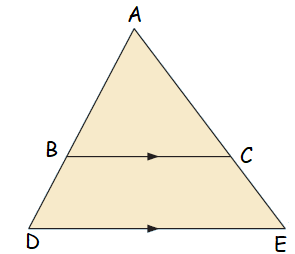
In triangles ABC and ADE. it is given BC is parallel to DE
<ABC = <ADB
<BAC = <DAE
Ratios of corresponding sides,
AC/AE = BC/DE = AB/AD
By applying the known values here, we can find the unknow.
In each of the following figures, establish that a pair of triangles is similar, and find x.
Problem 1 :
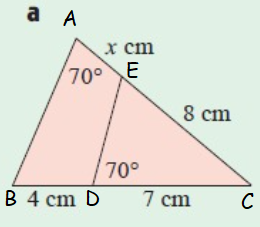
Solution :
In triangle ABC and in EDC.
<BAC = <DEC
<BCA = <DCE
So, the triangles ABC and EDC are similar.
BC/EC = AB/ED = AC/DC
(4+7)/8 = AB/ED = (x+8)/7
11/8 = (x+8)/7
77 = 8(x+8)
77 = 8x+64
8x = 77-64
8x = 13
x = 13/8
x = 1.625 cm
Problem 2 :
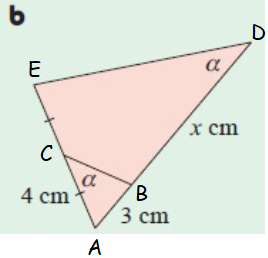
Solution :
<ACB = <ADE
<CAB = <EAD
So, the triangles ABC and AED are similar.
AB/AE = BC/ED = AC/AD
3/(4+4) = BC/ED = 4/(3+x)
3/8 = 4/(3+x)
3(3+x) = 32
9+3x = 32
3x = 32-9
3x = 23
x = 23/3
x = 7.66 cm
If the given triangles are similar, find the value of x.
Problem 3 :
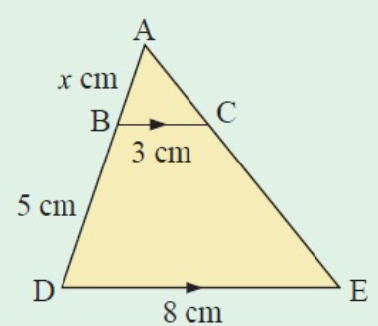
Solution :
BC/DE = AC/AE = AB/AD
3/8 = x/(x+5)
3(x+5) = 8x
3x+15 = 8x
8x-3x = 15
5x = 15
x = 15/5
x = 3
Problem 4 :
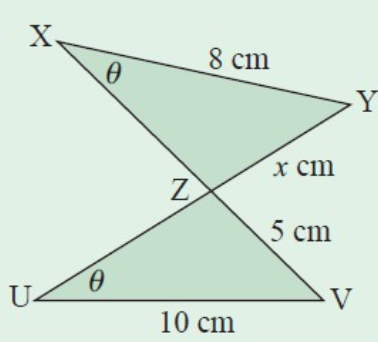
Solution :
ZV/ZY = UV/XY
5/x = 10/8
5(8) = 10x
40 = 10x
x = 4
Problem 5 :
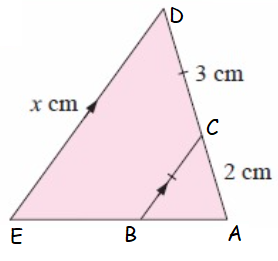
Solution :
BC/ED = AB/EA = AC/DA
BC/x = AB/EA = 2/5
BC/x = 2/5
3/x = 2/5
5(3) = 2x
15 = 2x
x = 15/2
x = 7.5 cm
Problem 6 :
Two triangles are shown below.
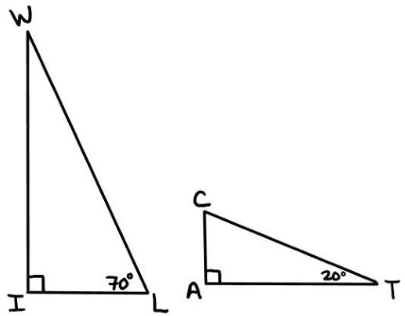
a) Find the missing angle in each triangle. How does this show that the triangles are similar?
b) If 𝑾𝑰 = 𝟗.𝟒 and 𝑾𝑳 = 𝟏𝟎. Find the side 𝑰𝑳 using the Pythagorean Theorem (to one decimal)
c) If the scale factor from 𝚫𝑾𝑰𝑳 to 𝚫𝑻𝑨𝑪 is ½, find all the missing sides of triangle 𝚫𝑻𝑨𝑪.
Solution :
a)
|
In triangle WIL <WIL = 90° <WLI = 70° <IWL = 180 - (90 + 70) = 180 - 160 = 20 |
In triangle ACT <CAT = 90° <CTA = 20° |
Since we have two angles measures are the same. The triangles are similar.
b) 𝑾𝑰 = 𝟗.𝟒, 𝑾𝑳 = 𝟏𝟎
Using Pythagorean theorem,
WL2 = WI2 + IL2
102 = 9.42 + IL2
100 - 88.36 = IL2
IL = √11.64
IL = 3.41
c) 1/2 of sides of the triangle WIL = sides of triangle ACT
|
(1/2) of WI = AT (1/2) of 9.4 = AT AT = 4.7 |
(1/2) of IL = AC (1/2) of 3.41 = AC AC = 1.7 |
(1/2) of WL = CT
(1/2) of 10 = CT
CT = 5
Problem 7 :
A 6 ft tall tent standing next to a cardboard box casts a 9 ft shadow. If the cardboard box casts a shadow that is 16 ft long then how tall is it ?
Solution :
Height of tent = 6ft
height of cardboard = 9 ft
Length of shadow of cardboard = 16 ft
length of shadow of tent = x
6 : 9 = 16 : x
6/9 = 16/x
6x = 16(9)
x = 144/6
x = 24 ft
So, length of shadow of tent is 24 ft.
Problem 7 :
When a Ferris wheel casts a 20 meters shadow, a man 1.8 meters tall casts a 2.4 meter shadow. How tall is this Ferris wheel ?
Solution :
Length of shadow of Ferris wheel = 20 meters
Height of man = 1.8 meters
Length of shadow of man = 2.4 meters
Height of Ferris wheel = x
x : 20 = 1.8 : 2.4
x/20 = 1.8/2.4
2.4x = 1.8(20)
x = 1.8(20) / 2.4
= 15 meters
So, the height of Ferris wheel is 15 meters.
Problem 8 :
A photographer measuring four inches wide and five inches long is enlarged to make a wall mural. If the mural is 120 inches wide, how long is the mural ?
Solution :
Length of original picture = 5 inches
Width of original picture = 4 inches
Width of mural = 120 inches
Length of mural = x
5 : 4 = x : 120
5/4 = x/120
5x = 120(4)
x = 120(4)/5
x = 24(4)
= 96 inches
So, length of mural is 96 inches.
Problem 9 :
A 9 foot ladder leans against a building six feet above the ground. At what height would a 15 foot ladder touch the building if both ladders against the same angle with the ground ?
Solution :
Length of ladder = 9 foot
The distance between foot of the building and top of ladder = 6 foot
Length of ladder = 15 foot
The distance between foot of the building and top of ladder = x
9 : 6 = 15 : x
9/6 = 15/x
9x = 15(6)
x = 15(6)/9
x = 10 foot
Subscribe to our ▶️ YouTube channel 🔴 for the latest videos, updates, and tips.
Kindly mail your feedback to v4formath@gmail.com
We always appreciate your feedback.
©All rights reserved. onlinemath4all.com
Recent Articles
-
SAT Math Practice
Dec 05, 25 04:04 AM
SAT Math Practice - Different Topics - Concept - Formulas - Example problems with step by step explanation -
10 Hard SAT Math Questions (Part - 37)
Dec 03, 25 07:02 AM
10 Hard SAT Math Questions (Part - 37) -
Factorial Problems and Solutions
Dec 02, 25 09:27 AM
Factorial Problems and Solutions

